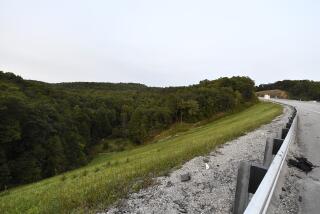‘Fun’ Shootings on Highways on the Rise
- Share via
WASHINGTON — A woman is shot while riding in a car on a highway in the capital. Authorities say the 19-year-old suspect told friends he just felt like killing someone.
A sniper in Massachusetts fires an M-1 rifle at a school bus filled with members of a girls’ basketball team. A 14-year-old dies.
“It’s like shooting at a target in a video game,” said James Alan Fox, dean of Northeastern University’s college of criminal justice.
“Psychologically, shooting someone on a freeway is much easier than having physical contact with a victim,” Fox said. “Vehicles are inanimate objects, little tin cans.”
The number of such slayings in the United States is now about 19 a year, and the figure has doubled in recent years, said Fox, who used FBI crime data to develop a computer database on murder.
Senseless acts of violence are on the rise and seem to be regarded as “sheer fun, sheer entertainment,” Fox said.
Henry James, according to authorities, said he just felt like killing someone. Police said he pulled out a gun, rolled down his car window and fired at the car in the next lane.
Patricia Diann Bigby Lexie, 36, died in the Nov. 16 shooting on a freeway here. Her husband was driving the car.
James, 19, was arrested and charged after police received a tip from an informant.
“You kill for the hell of it; there’s no sense of guilt,” said Marvin Wolfgang, a professor of criminology at the University of Pennsylvania who has lectured and written about the “subculture of violence.”
It’s a world in which an atmosphere of violence in the home and on the street is “almost a way of life,” Wolfgang said.
In the Massachusetts slaying, 24-year-old Scott E. Chipman was sentenced to life in prison for killing Robyn Dabrowski as she rode the team bus to a basketball game. An informant led police to Chipman.
“There is only one reason this man did this--for his own twisted version of fun,” Assistant Dist. Atty. John P. Corbett told the jury in Brockton, Mass. A second suspect is awaiting trial for the Jan. 5 killing.
The risk of a fatal traffic accident is incredibly high compared to the chance of being hit by gunfire in a car--it’s the unexpected that makes the crime so horrifying.
People feel safe in their cars, said Alfred Blumstein, dean of the school of urban and public affairs at Carnegie Mellon University.
Blumstein said the rise in such shootings began in 1987, the same year as a much-publicized outbreak of shootings on the Los Angeles freeways.
Some of that violence was due to short-tempered motorists getting angry at each other. One driver would cut off another and the cutoff artist would be shot. Other shootings were inexplicable, occurring on open stretches of highway.
Violence on the highways is nothing new. There were several shootings on Houston freeways during 10 months in 1982.
There is another dimension to this type of violence: Innocent bystanders struck by shots aimed at someone else.
Larry Sherman, a criminologist at the University of Maryland, said a young gang member may try to prove how tough he is by firing at passersby.
The number of bystanders killed or wounded in New York, Los Angeles, Boston and Washington tripled from 1986 to 1988, said Sherman, who reviewed newspaper computer databases to reach that conclusion.
“It used to be you got killed because of your relationships, domestic or business, a spouse, or drug dealers killing each other,” Sherman said.
“But random violence seems to be increasing, where it’s simply an accident of time and place.”
More to Read
Sign up for Essential California
The most important California stories and recommendations in your inbox every morning.
You may occasionally receive promotional content from the Los Angeles Times.










